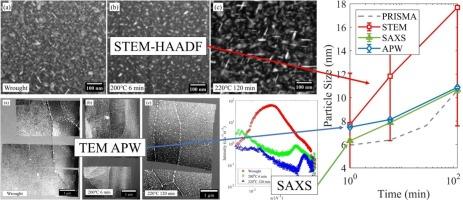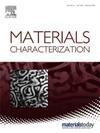利用 X 射线散射、电子显微镜和自动粒子计数技术量化 AA7050 中的纳米级沉淀
IF 4.8
2区 材料科学
Q1 MATERIALS SCIENCE, CHARACTERIZATION & TESTING
引用次数: 0
摘要
材料强度取决于多个因素,包括沉淀强化,这是 AA7050 铝合金的主要强化机制。这些合金含有大量纳米级沉淀物,在一系列热处理条件下,这些沉淀物会在整个晶粒和晶界中出现。本研究采用了三种不同的表征方法来表征这些纳米级析出物:传统的扫描透射电子显微镜(STEM);基于实验室的小角 X 射线散射(SAXS);以及赛默飞世尔科技公司开发的新型软件分析工具:自动颗粒工作流程(APW)。每种方法都用于确定 AA7050-T7451 试样中的平均沉淀尺寸和沉淀体积分数,T7 后热处理程序各不相同。STEM 技术测得的平均粒度为 7.6 至 17.6 nm,而 SAXS 测得的平均粒度为 6.3 至 10.7 nm,APW 测得的平均粒度为 7.4 至 10.8 nm。根据不同的方法,体积分数的测定值从 0.23% 到 16% 不等,而且最难量化。本研究的重要成果是 SAXS 和 APW 是确定平均粒度最准确的方法,今后需要开展工作,有效分析沉淀体积分数。本文章由计算机程序翻译,如有差异,请以英文原文为准。

Quantification of nanoscale precipitation in AA7050 using X-ray scattering, electron microscopy and automated particle counting techniques
Material strength is dependent on several factors, including precipitation strengthening, which is the main strengthening mechanism in AA7050 aluminum alloys. These alloys contain numerous nanometer-scale precipitates that occur throughout grains and along grain boundaries when subjected to a range of heat treatment conditions. In this study, three different characterization methods were used to characterize these nanoscale precipitates: conventional scanning transmission electron microscopy (STEM); laboratory-based small-angle X-ray scattering (SAXS); and a new software analysis tool developed by Thermo Fisher Scientific: automated particle workflow (APW). Each method was used to determine average precipitate size and volume fraction of precipitation in AA7050-T7451 specimens with variable post-T7 heat treatment procedures. STEM techniques measured the average particle size as ranging from 7.6 to 17.6 nm, compared to 6.3–10.7 nm for SAXS, and 7.4–10.8 nm for APW. Volume fraction determinations varied from 0.23 to 16 %, depending on method, and were the most difficult to quantify. Significant outcomes of the current study are that SAXS and APW are the most accurate methods for determining average particle size and that future work is needed to effectively analyze precipitate volume fraction.
求助全文
通过发布文献求助,成功后即可免费获取论文全文。
去求助
来源期刊

Materials Characterization
工程技术-材料科学:表征与测试
CiteScore
7.60
自引率
8.50%
发文量
746
审稿时长
36 days
期刊介绍:
Materials Characterization features original articles and state-of-the-art reviews on theoretical and practical aspects of the structure and behaviour of materials.
The Journal focuses on all characterization techniques, including all forms of microscopy (light, electron, acoustic, etc.,) and analysis (especially microanalysis and surface analytical techniques). Developments in both this wide range of techniques and their application to the quantification of the microstructure of materials are essential facets of the Journal.
The Journal provides the Materials Scientist/Engineer with up-to-date information on many types of materials with an underlying theme of explaining the behavior of materials using novel approaches. Materials covered by the journal include:
Metals & Alloys
Ceramics
Nanomaterials
Biomedical materials
Optical materials
Composites
Natural Materials.
 求助内容:
求助内容: 应助结果提醒方式:
应助结果提醒方式:


